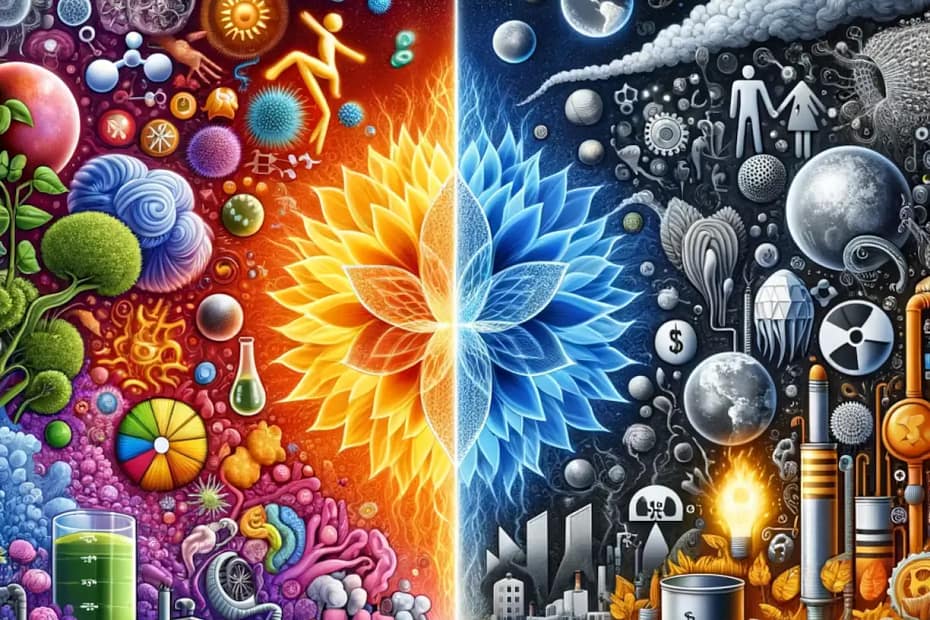Self-generated human energy, particularly manifested in the form of ATP, represents an intrinsic and fundamental life force for biological processes. ATP is the primary energy source for almost all cellular activities, including cell division, growth, repair, and general maintenance of the organism. This form of energy is notably anti-entropic, meaning it acts against the natural trend towards disorder (entropy) in the biological environment, sustaining the complex organization and functioning of living systems.
However, when we consider humanity’s journey beyond the agricultural era, we observe a significant transformation in the use of this vital energy. With the rise of complex and technologically advanced economic structures, the self-generated energy from ATP, which ideally would serve to sustain and perpetuate human life, has begun to be extracted more and more intensively for economic purposes.
This extraction is literal when we consider the transformation of human physical labor into energy to move and alter inanimate objects – a practice that has notably intensified since the Industrial Revolution. In this context, the human energy that should be directed towards growth, repair, and sustenance of one’s own body is instead channeled into economic production, operating machines, building infrastructures, and engaging in labor activities that are disconnected from the fundamental biological needs of the worker.
This separation not only highlights a contradiction between the biological and economic purposes of human energy but also represents a fracture in the human understanding of life’s place in the universe. In an ideal world, human activities would be in harmony with biological programming, contributing to the sustainability of the organism and the environment. However, the current economic model often operates in the opposite direction, prioritizing production and consumption over health and well-being.
Furthermore, the post-agricultural era has established a dynamic of owners and properties, intensifying the division between those who control the resources and those who provide the labor energy. This structure not only perpetuates inequalities but also justifies and normalizes the continuous extraction of human energy, masking the true destructive nature of this process as “necessary and acceptable work.”
This situation has created what we can consider a “human tragedy” – a profound disconnection between individuals and the true essence of their biological existence. Instead of living in consonance with the “intrinsic and self-sustaining key structure” inscribed in our DNA, many find themselves trapped in a cycle of work and consumption that neglects the fundamental needs of life in favor of economic goals.
Portuguese version:
Energia Auto Gerada Humana: Entre a Vida e o Lucro
A energia autogerada humana, particularmente manifestada na forma de ATP, representa uma força vital fundamental e intrínseca para os processos biológicos. O ATP é a principal fonte de energia para quase todas as atividades celulares, incluindo divisão celular, crescimento, reparação e manutenção geral do organismo. Essa forma de energia é notavelmente contrária à entropia, agindo contra a tendência natural à desordem no ambiente biológico, sustentando a organização complexa e o funcionamento dos sistemas vivos.
No entanto, ao considerarmos a jornada da humanidade para além da era agrícola, observamos uma transformação significativa no uso dessa energia vital. Com o surgimento de estruturas econômicas complexas e avançadas tecnologicamente, a energia autogerada do ATP, que idealmente deveria sustentar e perpetuar a vida humana, começou a ser extraída de forma cada vez mais intensiva para propósitos econômicos.
Essa extração se torna literal quando consideramos a transformação do trabalho físico humano em energia para mover e alterar objetos inanimados – uma prática que se intensificou consideravelmente desde a Revolução Industrial. Nesse contexto, a energia humana, que deveria ser direcionada para o crescimento, reparação e sustento do próprio corpo, é desviada para a produção econômica, operando máquinas, construindo infraestruturas e engajando-se em atividades laborais desconectadas das necessidades biológicas fundamentais do trabalhador.
Essa separação não apenas evidencia uma contradição entre os propósitos biológicos e econômicos da energia humana, mas também representa uma quebra no entendimento humano do lugar da vida no universo. Num mundo ideal, as atividades humanas estariam em harmonia com a programação biológica, contribuindo para a sustentabilidade do próprio organismo e do ambiente. Contudo, o modelo econômico atual frequentemente age em direção contrária, priorizando a produção e o consumo em detrimento da saúde e do bem-estar.
Além disso, a era pós-agrícola deu origem a uma dinâmica de proprietários e propriedades, aprofundando a divisão entre aqueles que detêm os recursos e aqueles que fornecem a energia laboral. Essa estrutura não só perpetua as desigualdades, mas também justifica e normaliza a contínua extração da energia humana, camuflando a verdadeira natureza destrutiva desse processo como “trabalho necessário e aceitável”.
Esta situação deu origem ao que podemos considerar uma “tragédia humana” – uma desconexão profunda entre os indivíduos e a verdadeira essência de sua existência biológica. Em vez de viverem de acordo com a “estrutura chave intrínseca e autossustentável” inscrita em nosso DNA, muitos encontram-se presos em um ciclo de trabalho e consumo que negligencia as necessidades fundamentais da vida em prol de objetivos econômicos.
